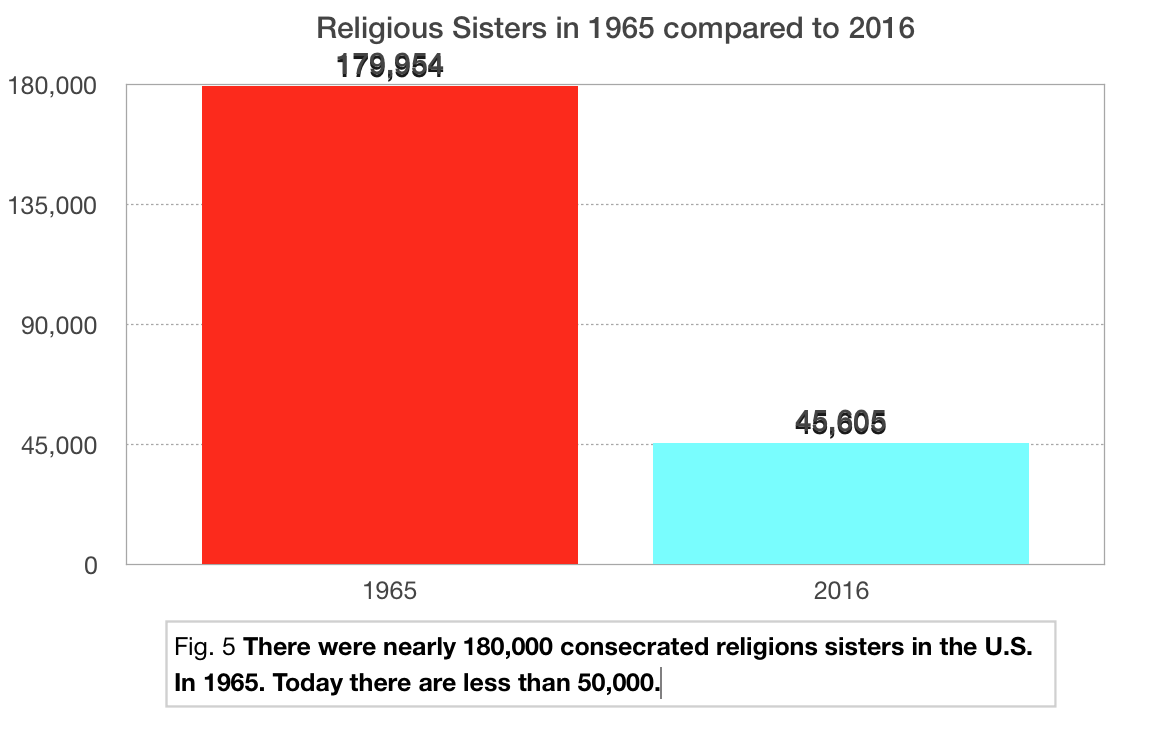A Church With A Vision
If you are a member of St. Cecilia Catholic Church, you have already heard that Fr. Walsh and the Parish Council are asking each parishioner to help develop the vision for the future of St. Cecilia Catholic Church. You are going to hear more about this in the near future. I wanted to help everyone see just how important this is for the future of the parish and the families in Hastings. My hope is that everyone will understand, what was once working, isn’t working anymore.
This is a long and potentially unsettling explanation. But please take the time to read this and consider the facts and statistics before you decide whether the vision process is something you want to help with or something you want to avoid. I’ll start with the big picture and get more specific as the blog goes on. As usual, I apologize for the length, but this is an important topic and it requires the analysis of a lot of information.
Why does St. Cecilia need to develop a vision?
Could the church waste away and disappear? Yes. I’m talking about St. Cecilia Catholic Church, Hastings Catholic Schools and other institutions and services connected to the Catholic Church. I’m not talking about the Universal Church we call the Catholic Church. The Universal Catholic Church will survive until Christ’s second coming. We know this from Scripture, such as Matthew 16:18-19. But Christ’s promise is not a promise to each individual parish, diocese or country. Therefore, our parish could disappear someday just as parishes, schools and hospitals are disappearing across North America and Western Europe. Unfortunately it looks like it is going to be even more common in the future if things remain unchanged.
“This is the way we’ve always done it”, is no longer an acceptable approach to the faith.
The Catholic Church was the first Christian Church, but it is no longer the only Christian Church. The Great Schism of 1054, separated the Eastern Catholic Church from the Western (Latin) Catholic Church. In 1517, Martin Luther sparked the Protestant revolution which resulted in millions of people leaving the Western (Latin) Catholic Church. Today, there are thousands of Christian denominations in the world and many pseudo Christian churches as well. This may lead some people to assume that Christianity is on the rise, but this is not the case.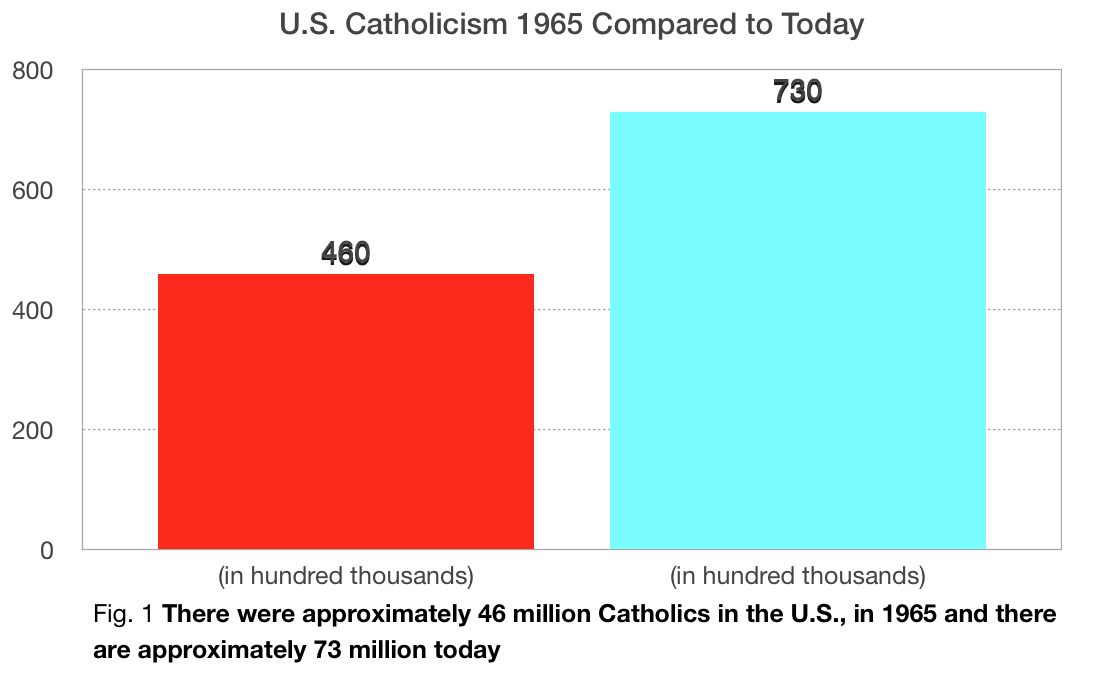
Worldwide, especially in Europe and the United States, Christianity is experiencing a rapid decline and Catholicism is experiencing the same or similar decline as non-Catholic denominations. One may look at the raw increase in the number of Catholics in the U.S. today and think that things are going in the right direction, but that would not give you an accurate picture of the real state of the Catholic Church in the United States today.[1]
First, researchers tell us that a significant portion of the 73 million Catholics in the U.S. today, are immigrants. In other words, were it not for immigration from Catholic countries such as Mexico and other highly Catholic Latin American countries, the Catholic population of the U.S. would not look so strong. Most mainline non-Catholic denominations in the U.S. do not have a large number of members who were recent immigrants, which is why denominations such as Southern Baptist, Presbyterian and Episcopalian, are experiencing a much more rapid decrease in membership than the Catholic Church is at this time. The problem is that the 2nd generation of immigrants are leaving the Catholic Church as fast or faster than the rest of the Catholic youth in the U.S.
A second fact to note is that a large number of Catholics do not practice the Catholic faith. In other words, we need to look at who is attending Mass on a regular basis, who is receiving the sacrament of marriage, who is receiving the sacrament of baptism, who is being ordained, etc… If we have a lot of Catholics, but very few of them are actually living the faith, we simply have a very large but absent population. There are other ways to measure the actual practice of the Catholic faith in the U.S., and we will look at some of those, but in doing this, we must always remember that the overall Catholic population of the U.S. has nearly doubled since 1965. Therefore, if all things remain the same, we should see a significantly higher number of people actually practicing the faith as well. But all things have not remained the same and we do not see an evident practice of the Catholic faith in a large majority of the population which identifies as Catholic. The “old way” isn’t working anymore.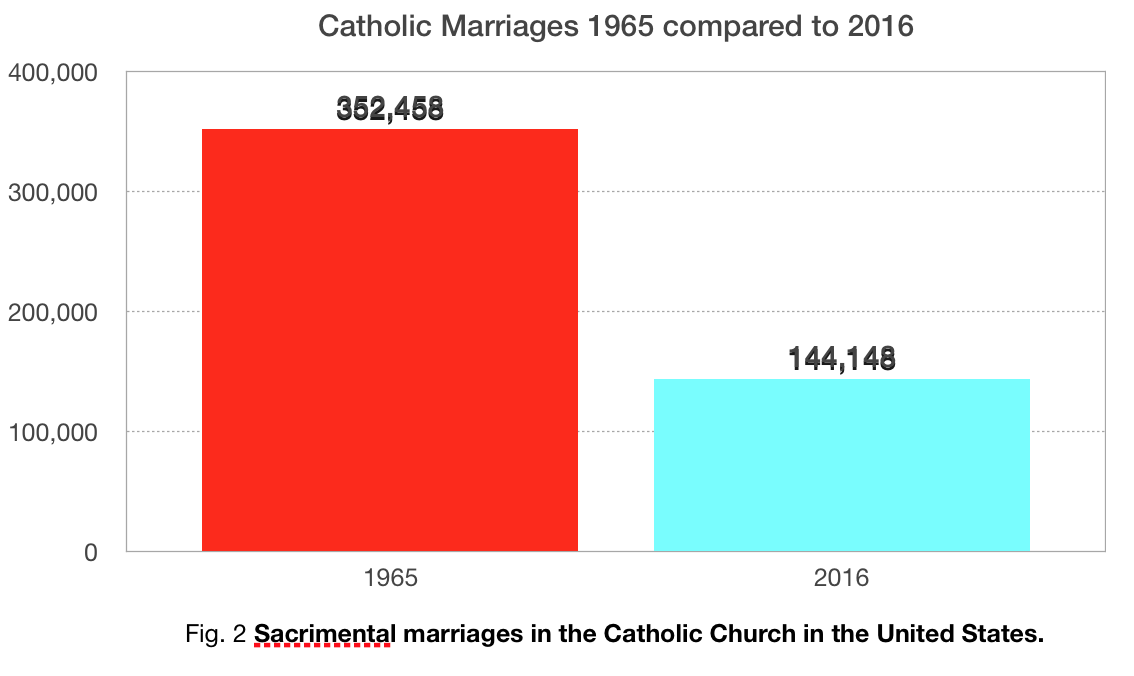
When we look at marriage, we see that columns go in the opposite direction. Even though there are a lot more Catholics in the U.S. today, we see about ½ of the sacramental marriages the Church celebrated in 1965 (fig. 2). Some of this is due to the fact that marriage is less common in the U.S. today, but if there were nearly twice as many faithful Catholics in the U.S. today, we would expect to see a much larger number of marriages in the Church as well, but we don’t.
We see the same inversion with regard to baptisms (Fig. 3)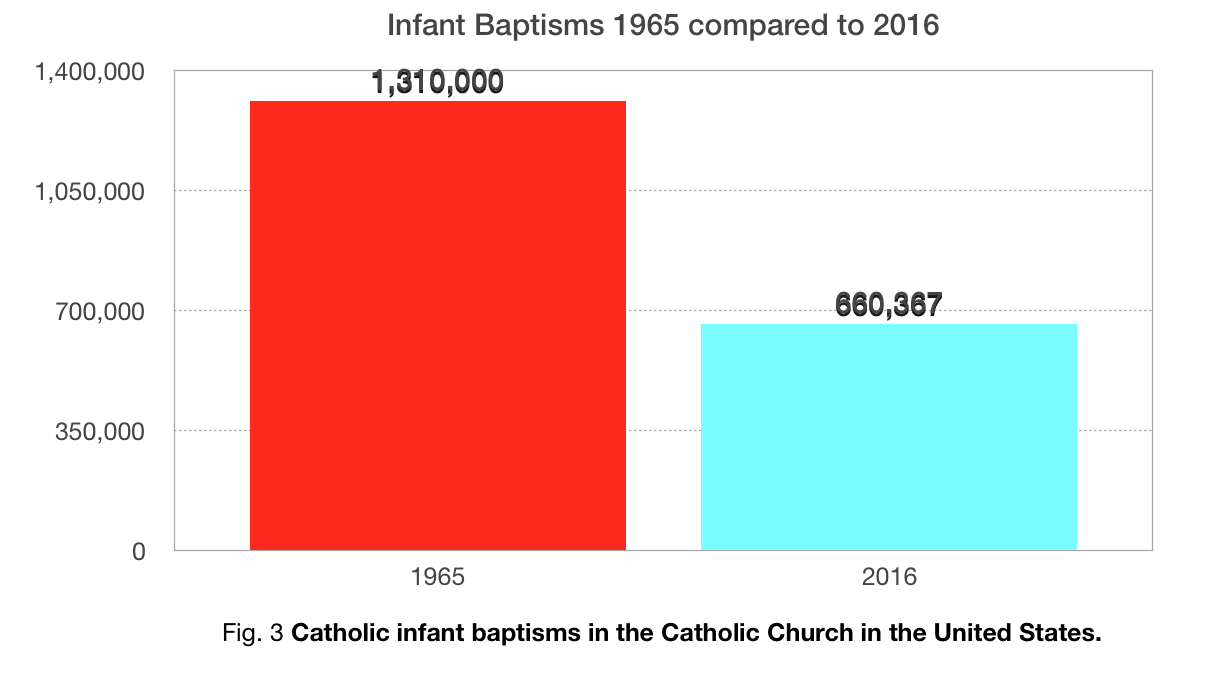
You might wonder if fewer marriages are simply creating fewer children. To a certain extent you would be correct. More Americans are waiting until they are older to marry and most American families have fewer children and have those children later in life than they did in 1965. In order to see if the marriage and baptism statistics are misleading, we can look at other comparisons between the 46 million Catholics of 1965 and the 73 million Catholics of today.
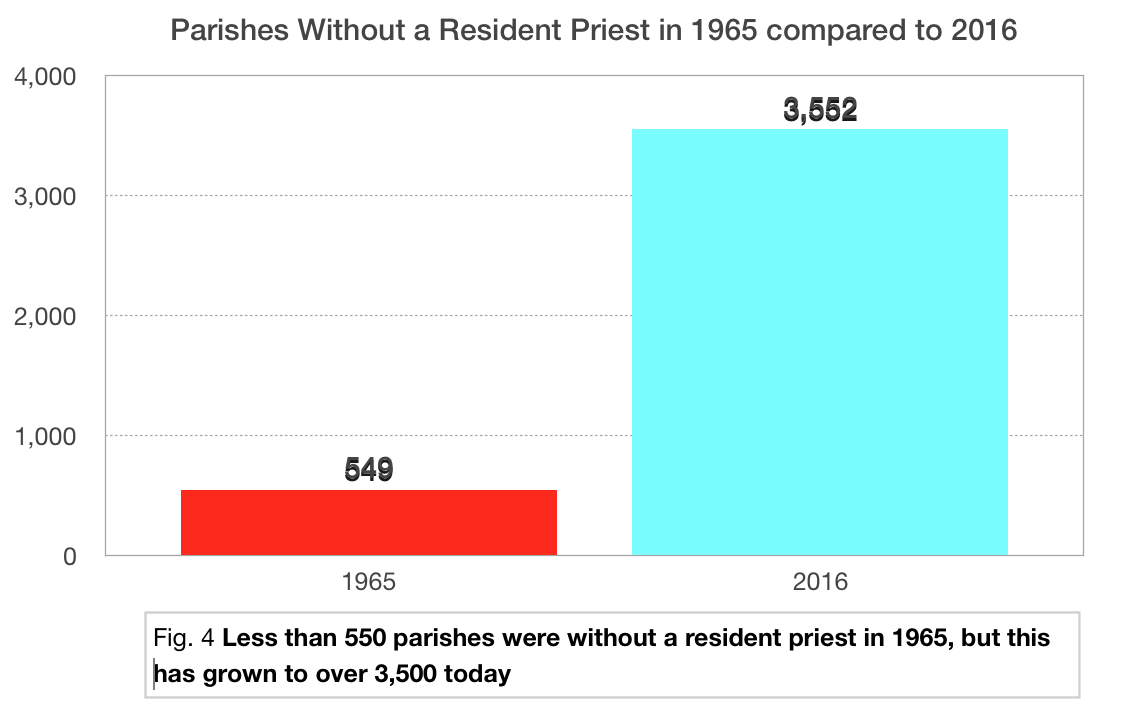 In Figure 4, we see that there has been an increase in parishes who do not have a resident priest (a pastor) who lives in the parish. Don’t let the colors confuse you on this one. Although the red is small, the lower number is the good number in this graph. The larger blue column shows that fewer priests are available for all the parishes in the U.S. today. Hidden within this is the fact that there are fewer parishes today than there were in 1965. There were 17,637 Catholic parishes in the U.S. in 1965. Today, there are 17,156. So while there are about 500 fewer parishes to cover, there are over 3,000 more parishes without a resident priest.
In Figure 4, we see that there has been an increase in parishes who do not have a resident priest (a pastor) who lives in the parish. Don’t let the colors confuse you on this one. Although the red is small, the lower number is the good number in this graph. The larger blue column shows that fewer priests are available for all the parishes in the U.S. today. Hidden within this is the fact that there are fewer parishes today than there were in 1965. There were 17,637 Catholic parishes in the U.S. in 1965. Today, there are 17,156. So while there are about 500 fewer parishes to cover, there are over 3,000 more parishes without a resident priest.
Related to this is the fact that there were 58,632 Catholic priests in the U.S. in 1965. Today we only have 37,181 priests in the U.S. Many dioceses are trying to bolster the numbers of priests by ordaining permanent deacons. There are a little over 18,000 permanent deacons in the U.S. today. Even if you include deacons in the overall number of ordained Catholic men, we still have fewer ordained men in the U.S. Catholic Church than we had in 1965, and deacons cannot adequately replace priests, regardless of how many deacons there are.
The fact is, many dioceses are struggling because there are too few men entering the priesthood. But this is merely the symptom of a deeper problem and that problem is that too few Catholics are actually practicing their faith. It is hard to inspire young men to consider devoting their life to a faith when those around them are not even devoting an hour per week to the faith. The result is that Catholic churches are being closed and parishes are being consolidated in many dioceses in the U.S., Canada and Europe. There are fewer people attending Mass on Sunday (and there is much less money being donated to keep churches open). Because of so many “non practicing” Catholics, the average Catholic household donates about $10.00 per week to their parish (that is per household, not per individual). Sadly, some beautiful churches built hundreds of years ago are being gutted and sold to people who turn them into housing, museums, mosques, Buddhist meditation centers and other unfortunate uses. Churches are not the only things closing. A former Los Angeles area convent owned by the Sisters of the Most Holy and Immaculate Heart of the Blessed Virgin Mary was recently purchased by none other than Katy Perry. Perry, a pop star, is well known for her disdain for Christianity and has renounced her parents’ Christian faith and has recorded and performed songs which promote the Occult, homosexual behavior and other beliefs and behaviors which are totally contrary to Christianity.
The priesthood is not the only segment of the Church which is struggling right now. In Figure 5, we see that the number of consecrated religious sisters has plummeted. Today, the U.S. Catholic Church has 25% of the nuns we had in 1965.
No matter where we look, we see a faith which has grown cold. There are fewer Catholic schools than there were in 1965 and there are fewer students in those Catholic schools. There are fewer children involved in CCD or other catechetical programs offered to Catholic children who do not attend a Catholic school. There are fewer religious brothers, fewer Catholic hospitals, fewer students in Catholic high schools and fewer people going to Mass on Sunday. In 1965, 55% of Catholics attended Mass each Sunday (nationwide). Today we are at a 23% attendance rate. This means that even with 73 million Catholics in the U.S. today, we have about 8 million fewer Catholics attending Mass each Sunday. It is hard to keep the furnace running and the lights on when people are not interested in their faith. The old approach is not only failing to keep Catholics faithful to the Church, it appears to be driving them away.
The Church spend a lot of time trying to evangelize people with the New Evangelization. How can we encourage non-Catholics to take a serious look at the Catholic faith when we are not even doing an effective job of encouraging Catholics to keep the Catholic faith. More on that toward the end of the blog.
I should not focus solely on the decrease in Catholic life since 1965. I should also point out the increases. There are now over 30 million former Catholics in the U.S. These are individuals who have formally declared their separation from the Church, so they are apparently not included in the current Catholic population of 73 million. However, we also know that approximately 56 million out of that 73 million, do not go to Mass on a weekly basis, so even if 30 million Americans identify as former Catholics, another 56 million are behaving suspiciously like former Catholics. Either way, the number of lapsed or former Catholics dwarfs the number of Catholics who are actively practicing the faith. Again, how can we consider converting non-Catholics to the faith when we can’t even retain people who grew up in a Catholic home?
The fastest growing segment of the Christian population in America are the “nones”. These are not religious sisters, they are former members of traditional mainline faiths such as Catholic, Lutheran, Methodist, Baptist, etc… who no longer identify as a member of any church. They still consider themselves Christian, but they have chosen to “go it alone” without any church, denomination or guidance. This is a new development in American Christianity, and it is taking Christianity by storm.
You may have heard people say that the Church is in a crisis. But hopefully you now have a little more appreciation for what that actually means. It means that in a few years, your parish may be on the auction block. In a few years, your child’s Catholic school may consolidate with another Catholic school across town or close down completely. Soon, your parish priest may live in a community 40 miles from your home.
Now for some local statistics.
But we are blessed to live in the Diocese of Lincoln, Nebraska, right? We make national headlines because we sometimes have more priestly ordinations per capita than almost all the other dioceses in the United States. There are some years when we have more young men ordained to the priesthood than most large metropolitan dioceses with many times our Catholic population. Our Catholic schools are strong, we attend Mass at a rate much closer to the 1965 rate of 55% than the current national rate of 23% and we have numerous religious orders who are thriving in our diocese. So why should a Catholic in the Lincoln diocese worry about all these depressing numbers regarding the condition of the Catholic Church in the rest of the country?
Because the same downward trend is happening in the Diocese of Lincoln. There were more priests, more ordinations, more nuns, more Catholic school students, more Catholic children in CCD and a much higher Mass attendance in the Lincoln Diocese in 1965. We are experiencing the same decline as the rest of the United States, but we started out healthier and our decline has been a little slower. While the Catholic population of the Diocese of Lincoln has grown significantly since 1965, our Catholic schools have not grown in size. We have more Catholics but fewer Catholic children in our schools and fewer Catholics showing up for Mass on Sunday. We have fewer baptisms, fewer marriages and fewer young men entering the seminary per capita than we did in 1965. In fact, even though we have a large number of seminarians studying for the priesthood for the Diocese of Lincoln, many of them actually grew up outside of the Diocese of Lincoln. Many of our diocesan priests grew up in Omaha and decided to enter the seminary while they were a student at the University of Nebraska in Lincoln. In other words, and I know this may not be a popular observation within our diocese, the Catholic families and parishes in the Diocese of Lincoln are not really inspiring as many young men to ordination as it may seem on the surface.
So even with impressive vocations to the priesthood in the Diocese of Lincoln, it appears that the Church is struggling here too, we are just declining slower than the rest of the dioceses in the U.S.
Some numbers that are even more local.
But my parish is a strong vibrant parish, right? Why should I fret over problems across the diocese when all I can really do is take care of my family and my obligations within my own parish and parochial school system? And since my parish is strong and we have classrooms full of students in our Catholic school, we don’t have any problems to address, right?
Talk to your pastor. How is the Mass attendance at your parish compared to a few years back? How is the charitable giving in your parish? Are finances frequently in the black or is your parish finance committee frequently wondering how the bills are going to get paid in the next quarter? If your finances are in good shape, how about the average age of your parish membership? How many households are registered this year compared to 1990 or 1965? How many parishioners left the parish in the last year?
Here is how things look at St. Cecilia.
- In 1968, St. Cecilia parish had 2,264 registered members at a time when the total population of Hastings was about 22,000.
- 1,137 of the 2,264 registered members were under the age of 19.
- Cecilia parish now has 2,163 registered members and the population of Hastings is approximately 25,000.
- 898 of St. Cecilia’s members are under the age of 19.
- In 1965, St. Cecilia High School had an average of 66 students in each the four high school classes.
- Today, St. Cecilia High has an average of 38 students enrolled in each of the four high school classes.
- There are 35 students in the St. Michael Kindergarten class this year.
- In 1965, the average Mass attendance at St. Cecilia was approximately 65%.
- Last year it was 53%.
- There were 63 infant baptisms at St. Cecilia in 1968[2].
- Last year there were 52.
- There were 27 marriages at St. Cecilia in 1968.
- Last year there were 21.
- Cecilia had 738 households registered in 1968.
- There were 762 households registered at the beginning of 2017, but not by the end of the year.
- As of the end of 2017, there were 729 households registered in St. Cecilia parish, a decrease of 33 households in one year.[3]
What do the statistics tell us?
Our parish is smaller and more aged than it was 50 years ago. We have fewer members and fewer children in the parish. Not only that, but the members we have are attending Mass less often than we did in 1965. There are also fewer baptisms, fewer marriages and fewer households than there were in 1968. These are not exceptions to the average year. For 5 decades, there has almost always been a little bit of a decrease in these statistics in each successive year. We also have seen no growth in our Catholic school enrollment which many see as another way to estimate the loss, stagnation or growth of the faith. I should note that many high schools had high enrollment numbers in the 60’s, so the high enrollment in St. Cecilia High School is likely due to the baby-boom after WWII. However, if there was growth in the 1960’s we should not see such a dramatic dip in enrollment today. Many graduates from the 1960’s remained in Hastings and started families of their own. Many still live in the area today.
These local statistics show us that St. Cecilia could be a stagnating parish located in a city many consider to be almost totally stagnant which exists within a nation which is growing less Christian each day. Our local statistics would look a lot more like the national statistics if it were not for immigration. Hastings in general, St. Cecilia parish and Hastings Catholic Schools, have all benefited from the immigrants who have settled here from Catholic countries. Hastings has not experienced a significant growth in population in the last 50 years, but what growth we have has been due to a growing Hispanic community as well as a brief period of immigration from Vietnam. Most of these immigrants are Catholic or were Catholic at one time and they account for a significant portion of the baptisms and marriages at St. Cecilia in the recent past.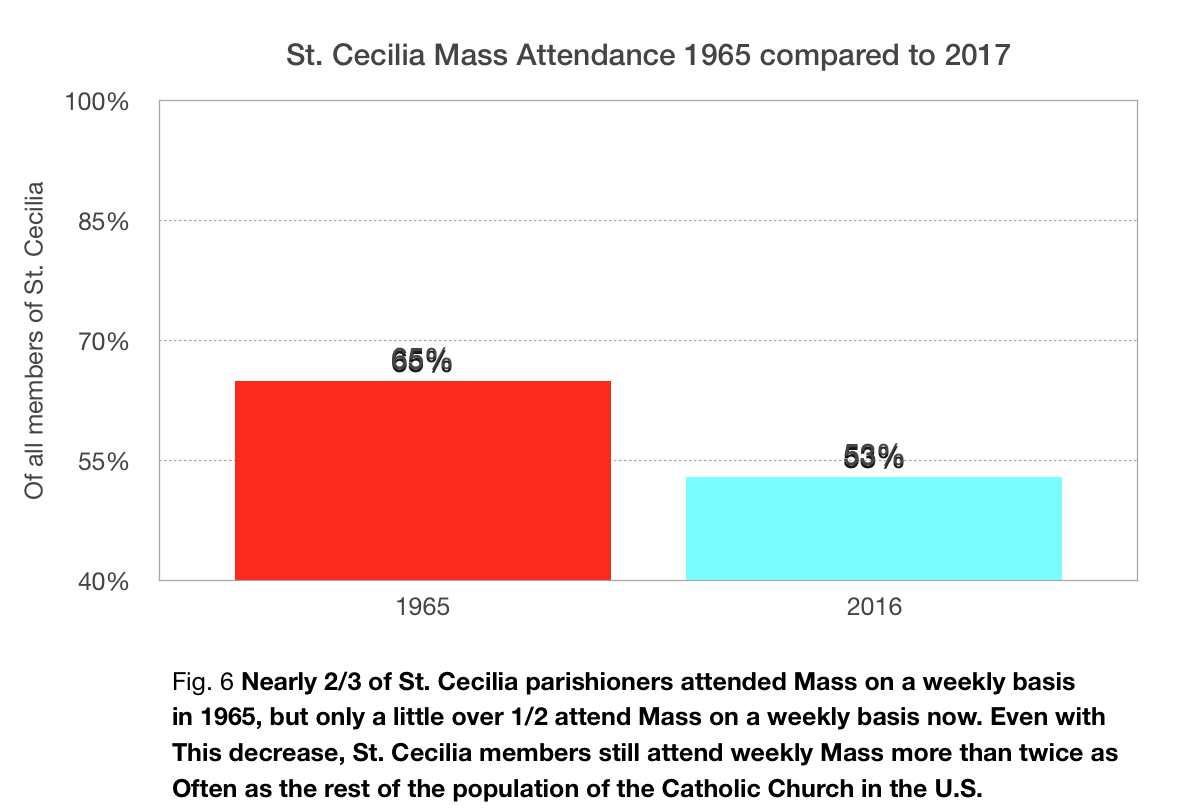
What does all of this mean? It means that whatever we have been doing for the past 50 years, it does not appear to be working. As a matter of fact, it appears to be causing a significant erosion of the Catholic faith nationally and locally.
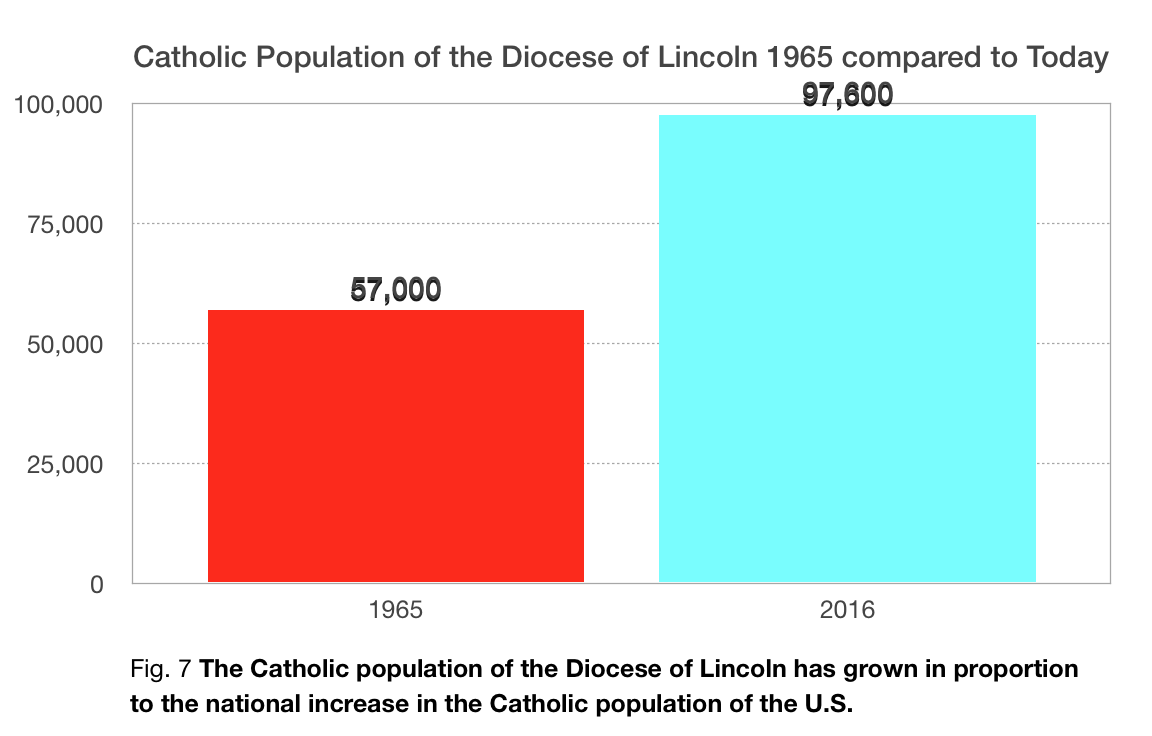 National statistics are one thing, but when we look at our local statistics, we see one of two things, nearly zero growth or decrease. Over the past 50 years, we have had over 2,000 students graduate from Hastings St. Cecilia. Many of those graduates live and work in and around Hastings today, but far too many of them are not registered at a Catholic parish and too many do not send their children to Hastings Catholic Schools. There are hundreds of local St. Cecilia graduates who have received 4 sacraments while in Hastings Catholic Schools, and may have been married in a Catholic Church, yet they do not regularly participate in the life if the Church today.
National statistics are one thing, but when we look at our local statistics, we see one of two things, nearly zero growth or decrease. Over the past 50 years, we have had over 2,000 students graduate from Hastings St. Cecilia. Many of those graduates live and work in and around Hastings today, but far too many of them are not registered at a Catholic parish and too many do not send their children to Hastings Catholic Schools. There are hundreds of local St. Cecilia graduates who have received 4 sacraments while in Hastings Catholic Schools, and may have been married in a Catholic Church, yet they do not regularly participate in the life if the Church today.
As we see in Figure 7, the national population of Catholics and the Dioceses population of Catholics have both grown significantly, but the population of Catholics who are registered in the two parishes in Hastings has not grown at all, nor has the enrollment in Hastings Catholic Schools. We are going in the opposite direction.
There are currently 898 children registered as members of St. Cecilia Catholic Church. It is safe to estimate that St. Michael has a similar number of children registered in their parish. This means that there are approximately 1,800 children in Hastings who are living in a household which is registered in one of the two Catholic churches in town. Approximately 1,300 of those children are school-aged, meaning that they are either enrolled in the public school system, the Catholic school system or they are home-schooled or attend a nearby non-Catholic private school. If we average the Hastings Catholic Schools at 40 students per class (which is a high estimate) for K-12 enrolment, we come to 520 students. Hastings Catholic Schools does not have 520 students in its system, but even if it did, that would make it the 2nd largest educator of Catholic youth in Hastings behind the public school system (Hastings Public Schools and Adams Central combined). Only about 1/3 of Catholic youth in Hastings are enrolled in the Catholic school system in Hastings.
If the alumni of Hastings Catholic Schools, who continue to live in Hastings were to send their own children to Hastings Catholic Schools, the current facility would not be able to accommodate all of the students. In saying this, I recognize that the majority of STC graduates actually move away from Hastings after graduation for at least some period of time. However, this may happen at a lower rate if there were more fervor for the faith at the local level. Some young Catholics are attracted by a deep and meaningful life of faith, and this type of culture does not have to be limited to monasteries, orthodox religious orders or Catholic communities outside of Hastings, Nebraska. For purposes of this discussion, the focus is really on the graduates who stay in Hastings after graduation. If more of these graduates would send their children to the Catholic schools, we would not see a decline in the number of students. We would only see growth. But the fact remains that many graduates who remain local are not sending their children to Hastings Catholic Schools. In some cases we know the reasons, but in many cases, we can only speculate. We should be doing more to make sure today’s graduates have good reasons to send their kids to Hastings Catholic Schools when they start their family and the “more” must start at the parish level!
We should also be doing more to encourage each Catholic family to enroll their children in Hastings Catholic Schools whether they are alumni or not. If we had 1,300 students enrolled in Hastings Catholic Schools and each of those families were engaged and active in the life of the parish, it would change the culture of the entire population of Hastings in a very positive and profound way.
A brief return to some National, diocesan, then local numbers and facts:
Researcher and author, Sherry Weddell has spent decades studying Catholics at the parish level. She has found that about 85% of Catholics who leave the Church, do so by their 25th birthday. This estimate is accepted by other writers, researchers and speakers in the Church such as Bishop Robert Barron, Matthew Kelly, and Chris Stefanik. A recent study found that the average age of departure is 13 years old.[4] This same study focused on looking at the reasons these children provided as to why they decided to leave the Catholic faith. All the reasons can be combined into a few brief bullet points:
- They were not inspired by the other Catholics in their life;
- They were not inspired by the information they were provided in their religion, theology or CCD classes;
- They were never inspired to take personal ownership of the Catholic faith (i.e. They cooperated with the faith of their parents and their family for a time, but eventually, they just didn’t see the point in it anymore).
A lot of this is due to the corruption of the culture outside the Church, but a significant part of it is simply due to technology. Author and psychologist, Dr. Jean M. Twenge, has recently published a book titled iGen: Why Today’s Super-Connected Kids Are Growing Up Less Rebellious, More Tolerant, Less Happy–and Completely Unprepared for Adulthood–and What That Means for the Rest of Us. The title is nearly as long as the book, but what she has found is pretty simple. Once the smartphone came into possession of over half of the teenagers in the U.S., there was a wide cultural shift in behavior. Twenge defines the iGen generation as youths under the age of 23. Based on her book and other observations by psychologists and researchers, the next 20 years will likely be more devastating on Christianity and the family than the previous five decades have been.
There were over 500,000 confirmations in the American Catholic Church in 2017. The average age for confirmation in the U.S. is age 13, but only about half of the children baptized in 2004 showed up for their confirmation in 2017. Worse yet, people like Archbishop Charles J. Chaput, Fr. James Mallon (Author of Divine Renovation), Brandon Vogt and Matthew Kelly, tell us that a large percentage (over 50%) of those confirmed as a child, leave the Church within 12 years of their confirmation date. Some estimate this to be more than 250,000 lapsed Catholics out of each confirmation class. If that is true, the number of former Catholics increases by at least one quarter of a million each year and the average lapsed Catholic is still not old enough to legally drive himself or herself to school.
Sadly, our situation in Hastings is similar. Our diocese confirms its youth earlier than most other dioceses. Catholic children in the Diocese of Lincoln are usually confirmed in the spring of their 5th grade year when most of them are 11 or 12 years old. In order to see if our youth leave the Catholic faith at a high rate after confirmation, we can look at our CCD enrollment. Each year, the 6th grade CCD enrollment is about 50% of what the same class was in 5th grade. In other words, after receiving the sacrament of confirmation, about ½ of CCD students stop coming to CCD. In many cases, they stop all other visible practices of the Catholic faith as well.
In the past, those who stopped practicing the faith during their teenage or college years, returned to the Catholic faith as soon as they married or started a family. As we have seen above, this is not the case any longer because fewer Catholics are getting married in the Church and fewer yet are having their children baptized. Those who do have their children baptized evidently drift away before their child reaches confirmation age and of those who make it to confirmation, about 50% stop practicing their faith soon thereafter.
This is really depressing right? But there is good news.
In spite of all of this, Fr. Walsh sees signifiant signs of great hope and opportunity at St. Cecilia.
Contrary to the national trend, St. Cecilia still has a large number of young families and large families in the congregation. Many of the marriages and baptisms are in families who have been members of St. Cecilia for a long time and many of them are from families who have been sending their kids to Hastings Catholic Schools. On top of this, we all see these families at Mass on Sunday.
But faith is not all about youth. The people of St. Cecilia are a people of prayer. We are one of the small percentage of parishes in the U.S. which has exposed perpetual adoration. There are prayer groups, Bible studies and other opportunities for spiritual growth throughout the week as well, and many parishioners lead these effort and many more participate in them.
St. Cecilia also has two shining examples of the faith of the earliest Christians: Hastings Catholic Schools and the Health Ministry.
The school has been part of the Hastings Catholic community for over 100 years but the Health Ministry has only been part of the fabric of the community for less than five years. Regardless of their longevity, these two ministries echo 2000 years of the Catholic response to the needs of all people. We all need to be educated and we all need care when our health is failing. No nation, faith or organization has done this better than the Catholic Church, and St. Cecilia is now doing both right here in Hastings. At a time when Catholic schools are closing and Catholic health providers are under serious pressure to violate their consciences, we have a stabilized school and a growing Health Ministry who are positively impacting lives in our own families and in our own neighborhood.
Several years ago, Hastings Catholic Schools was in a precarious position. Enrollment had been high, but the financial condition was dire, moral was low among school families and school leadership and a large number of families decided to enroll their children elsewhere after the end of the school year. In many communities across the country, this would have ended with the closure of the school. But Hastings Catholic Schools did not close, in fact, the administration, staff, parish leadership and parents all pulled together and worked out a solution which has made the school system much stronger, increasingly sustainable and more dedicated to the mission of the Catholic faith, which is to “go and make disciples”.
The new Health Ministry is going to homes and into the nursing homes and hospital to reach people that have been beyond the reach of our priests. This is because some of the people reached are not Catholic and some who are Catholic but who are not members of St. Cecilia. Even more importantly, instead of two priests visiting people in the hospital, nursing homes and visiting those who cannot leave their own home, we now have 3, 4 or 5, additional individuals making visits. Although the nurses are not able to administer any sacraments, nor can they stand in the role of a spiritual father, they are trained in both nursing and in spiritual care and they offer a connection to the rest of the parish. This has proven to be a powerful experience for the individuals receiving the care as well as their families.
For these reasons as well as the growing Hispanic membership, I+U=We marriage workshops, the upcoming Rosary Crusade, etc… , Fr. Walsh sees great hope and great opportunity among the people of St. Cecilia parish. If we didn’t have hope, why would we need a vision?
We also have signs of hope in our diocese. We have more priests and more seminarians studying for the priesthood (per capita) than most dioceses in the U.S. We have strong religious orders such as The Sister Servants of the Holy Spirit of Perpetual Adoration (Pink Sisters), the Carmelites, the Knights of the Holy Eucharist, The School Sisters of Christ the King and The Priestly Fraternity of St. Peter.
St. Gregory the Great Seminary is growing, as is the Newman Center at the University of Nebraska which just built a beautiful new church adjacent to the UNL campus. Additionally, our Catholic grade schools and high schools still have numerous priests and nuns on staff (which is rare in Catholic schools across the country).
Why might these positive things matter?
Precisely because the Catholic faith is still more evident and likely stronger here than in much of the rest of the U.S. If the faith weakens much further in the rest of the U.S., and all indications are that it will, the remaining Catholics will need to draw closer to other faithful Catholics. In a sense, it is kind of like the remnant of Israel in the Old Testament. If there is to be a remnant of the Church in the United States in coming years, there are only a few dioceses who could serve as that remnant. Why not the Lincoln Diocese and why not St. Cecilia within the Diocese of Lincoln? What better place to preserve the faith an then to aid in the rebuilding of the culture than the heart of the country?
This isn’t an apocalyptic concept, it is one that has been repeated time and time again throughout the history of the Church. Through 20 centuries, the Catholic Church has struggled, persisted and thrived, but it has never failed. The Church will always prevail because of the promises of Christ and the guidance of the Holy Spirit. However, as I mentioned at the beginning of this blog, that promise is to the Universal Catholic Church, not to any one individual parish. If the Holy Spirit is waiting for the people of St. Cecilia to step up and stand in the breach, we have a great opportunity to do that today.
What can I do as an individual Catholic?
One of the many beautiful things about the Catholic Church is the fact that it is truly universal and the parishes and dioceses form a network of faithful Catholics which spans the globe. This is one of the reasons why the Church has survived 20 centuries which have included prolonged periods of intense persecution, periods of inept leadership and periods of intense temporal and supernatural attack of the prince of darkness. After each of these periods, the faithful have risen up to fill the churches and schools run by the One, Holy, Catholic and Apostolic Church.
Therefore, we cannot and should not worry about problems in the European Catholic Church, the Church in the United States or even certain dioceses which appear to be on a path to extinction. We should only focus on our own family, parish and community, under the spiritual guidance of our pastor and our bishop.
This is why your input is needed on the vision of St. Cecilia Catholic Church. It is time to step into the breach and defend St. Cecilia, because in doing so, you defend the community, Hastings Catholic Schools and the rest of the Church founded by God Himself.
We need to seize the opportunities we have right now. We must take care of our own families and our own parish. Right now, St. Cecilia is conducting a visioning process which will develop a vision of what St. Cecilia is going to look like in 20 years. With knowledge about the trajectory of the Church, we can develop a vision which will help St. Cecilia navigate against the trend in order to serve as a safe harbor for our children and grandchildren when they are raising their families amidst a culture which will likely be hostile to all the Church teaches. But even more important than being a safe harbor, St. Cecilia can become a parish which attracts people to Hastings and therefore, to Hastings Catholic Schools, local businesses and into the broader culture of central Nebraska.
With vision, we can prepare ourselves to attract, receive and retain, vibrant families who value virtue, sacrifice for the love of neighbor and have a fervor for the Catholic faith. Without a vision, St. Cecilia will be pushed and pulled by the current of the culture and there is no guarantee the parish will survive that current. The lack of vision is part of the “old way” but forming a vision will help St. Cecilia reverse the trend.
We know that many other parishes across the country have recently finished or are in the process of working on their own vision. If enough Catholics are proactive, the American Catholic Church will not only stand strong in the current around us, it will be here to help repair lives when flood subsides.
[1] The statistics for figures 1-5 are based on data from the Center for Applied Research in the Apostolate (CARA) which is a Catholic research center which conducts social scientific studies about the Catholic Church.
[2] We could not locate most of the 1965 figures for St. Cecilia. It would be better to see the 1965 figures because the sexual revolution would not impact the 1965 figures as much as it did by 1968. However, we had to use the closest numbers we could find. It is safe to conclude that the 1965 figures would reflect a greater engagement in the life of the Church than the figures we see from 1968, but at this time, we don’t know just how significant that would be.
[3] Reasons for leaving the parish included death, relocating outside the parish or they left the Catholic faith. The reduction would be greater but 10 new families registered at St. Cecilia within the same year.
[4] https://www.smp.org/product/5926/Going-Going-Gone/


